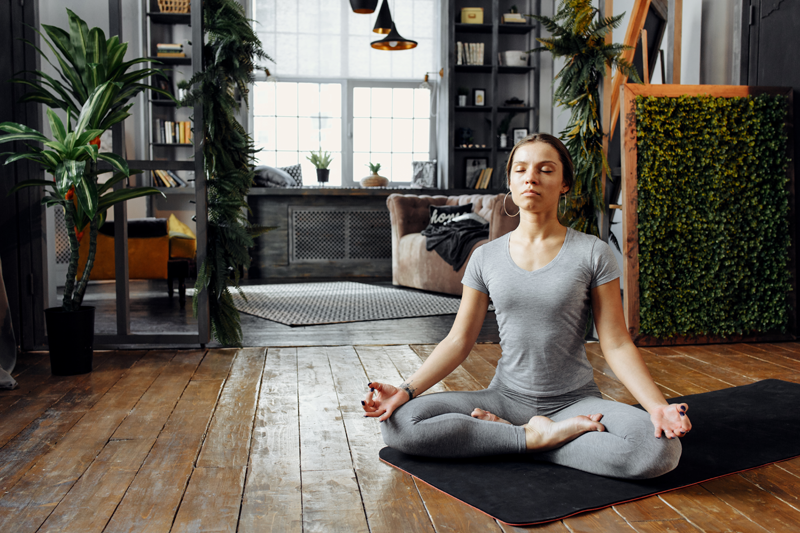It’s no secret that meditation has several health benefits. Contrary to popular belief, the practice does not take years to learn, nor do you have to attend a meditation class or seminar. With regular practice, you can learn how to meditate from the comfort of your own home. If you struggle to focus, you may benefit from some mindfulness yoga jewelry. This way, you can get into the right mindset before you begin. In this article, we explore exactly how to start meditating at home.
What You’ll Need
1. Something to Sit On
To meditate at home, the first thing you’ll need is something to sit on. We explore the most popular options below.
A Chair
Chairs are great to sit on during meditation. As well as being popular amongst beginners, they are helpful for those with back problems who may find a cushion uncomfortable. If you’re new to meditation, you may prefer to use a chair for the first few times instead of buying a meditation cushion. Once you become more comfortable with the practice, you can decide whether it’s worth purchasing a cushion or bench.
A Meditation Cushion
A meditation cushion is the most popular thing to sit on during meditation. The cushion promotes good posture and allows you to sit in an upright position. As well as being good for your back, this position improves your focus and quality of the meditation. When sitting on a chair, you may be tempted to slump and consequently lose focus.
A Meditation Bench
If you’re taller, you may find a meditation cushion uncomfortable. In this case, it’s worth trying out a meditation bench. Unlike a chair, the bench will force you to sit upright and not slump. Meditation benches also take the weight off your legs, which makes the practice much more comfortable.
2. A Timer
The second thing you’ll need for meditation is a timer. While you can buy meditation-specific timers, you may find it easier to use your phone. Almost every phone has a timer built-in. To avoid unnecessary distraction, put your phone on silent before you begin. If you have a smartphone, you could even use a meditation app to record your time.
How to Sit
During meditation, the most important thing to remember is to keep your back straight. If you’re sitting in a chair, it’s best not to rest your back on the back of the chair; instead, keep your back erect in an upright posture. This position keeps you alert and allows you to focus on your breath. During meditation, you can have your eyes open or closed. The goal of the practice is to increase your attention muscle. If you can concentrate better with your eyes open, keep them open. If you find it easier to have them closed, keep them closed. If you meditate before bed, you may find that closing your eyes causes you to drift off. If this happens, try opening them slightly and gazing softly at something in the room. Many people find staring at a blank space on the floor is the least distracting.
In terms of your hands, have them however you feel comfortable. You’ve probably seen people form circles with their thumb and another finger, but this isn’t a necessity. For best results, rest your hands wherever they feel most comfortable. If possible, try to keep your legs crossed. If you want to fold them into a meditation-specific posture, you can. However, remember that the goal of meditation is to work your attention muscle. With this in mind, it’s best to keep your legs in a comfortable, non-distracting position. Finally, tilt your head forward slightly to open your chest.
What to Do
Get Comfortable
Once you’ve got your equipment and figured out how to sit, you’re ready to start meditating! Open the timer on your phone and get into a comfortable position. To create a calm environment, dim the lights slightly or turn them off completely. How long you meditate for is totally up to you. Typically, beginners find it best to start with two minutes and work their way up.
Focus on Your Breath
Next, start your timer and focus on your breath. With a soft gaze or your eyes closed, feel your breath as it enters your body and leaves through your nose. Which element you focus on is totally up to you. Some people think about how the air feels as it enters and exits the nose and others focus on how it feels as you inflate and deflate your lungs. Some people even focus on the sound you make as you breathe. Whatever element you choose to focus on, don’t force your breathing. Breathe gently and observe it without question.
Don’t Think
The final and hardest part of meditation is to not think. Don’t analyze your breath; instead, simply observe it without question. If your mind starts to wander – and it will – gently bring your attention back to your breath. It may take a couple of seconds before you realize that your mind has started thinking, but when you do, guide your attention back. Don’t be too hard on yourself during this stage, you’re only human and you’ll get there in the end. Throughout your practice, guide your wandering mind back to your breath until your meditation timer sounds. When it does, remain in position for a few minutes whilst you bring yourself back to reality.
In Summary
With the guidance above, it should be easy enough to start meditating at home. If you find yourself struggling, seek the advice of a friend, family member, or even the internet. If one technique doesn’t work for you, don’t panic. You may need to try a few different methods before you find a good fit. In the summer months, some people enjoy meditating outside. To protect your skin from the UV rays, remember to wear a yoga cap and some good-quality sunblock.

